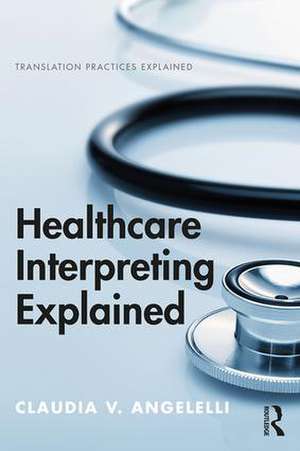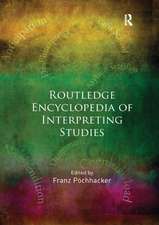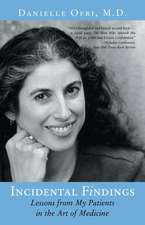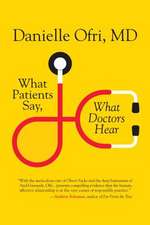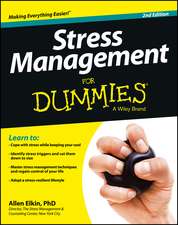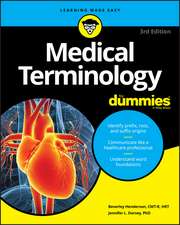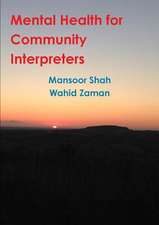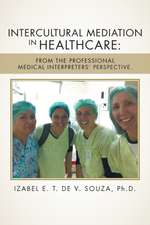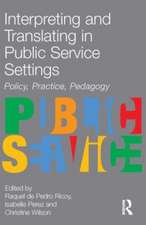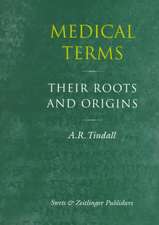Healthcare Interpreting Explained: Translation Practices Explained
Autor Claudia Angelellien Limba Engleză Paperback – 31 mai 2019
Medical Interpreting Explained is based on the premise that the purpose of medical interpreting is to facilitate and achieve successful communication in a variety of medical situations and among diverse participants.
The text will help students to become good medical interpreters with a full awareness of the many different aspects related to their profession other than just translation and terminology. The book encompasses medical discourse, ethics and protocol, domain typologization, professionalization, cognitive factors, techniques and strategies, resources and assessment among others. The book is highly practical and is structured to facilitate learning by offering further tasks, learning outcomes and observe, investigate and reflect sections.
It is essential reading to students and instructors of Translation and Interpreting Studies as well as professional health-care and medical interpreters.
| Toate formatele și edițiile | Preț | Express |
|---|---|---|
| Paperback (1) | 367.23 lei 43-57 zile | |
| Taylor & Francis – 31 mai 2019 | 367.23 lei 43-57 zile | |
| Hardback (1) | 766.49 lei 43-57 zile | |
| Taylor & Francis – 29 mai 2019 | 766.49 lei 43-57 zile |
Din seria Translation Practices Explained
-
 Preț: 289.61 lei
Preț: 289.61 lei -
 Preț: 279.69 lei
Preț: 279.69 lei -
 Preț: 268.22 lei
Preț: 268.22 lei -
 Preț: 288.80 lei
Preț: 288.80 lei -
 Preț: 280.81 lei
Preț: 280.81 lei -
 Preț: 305.43 lei
Preț: 305.43 lei -
 Preț: 265.72 lei
Preț: 265.72 lei -
 Preț: 303.87 lei
Preț: 303.87 lei -
 Preț: 346.46 lei
Preț: 346.46 lei -
 Preț: 309.50 lei
Preț: 309.50 lei -
 Preț: 233.92 lei
Preț: 233.92 lei -
 Preț: 287.04 lei
Preț: 287.04 lei -
 Preț: 289.93 lei
Preț: 289.93 lei -
 Preț: 228.76 lei
Preț: 228.76 lei -
 Preț: 354.62 lei
Preț: 354.62 lei - 17%
 Preț: 271.43 lei
Preț: 271.43 lei -
 Preț: 467.10 lei
Preț: 467.10 lei - 5%
 Preț: 323.23 lei
Preț: 323.23 lei -
 Preț: 290.36 lei
Preț: 290.36 lei -
 Preț: 410.46 lei
Preț: 410.46 lei -
 Preț: 380.36 lei
Preț: 380.36 lei -
 Preț: 364.17 lei
Preț: 364.17 lei - 17%
 Preț: 246.74 lei
Preț: 246.74 lei - 13%
 Preț: 266.19 lei
Preț: 266.19 lei -
 Preț: 447.17 lei
Preț: 447.17 lei - 22%
 Preț: 371.87 lei
Preț: 371.87 lei - 13%
 Preț: 321.08 lei
Preț: 321.08 lei -
 Preț: 395.85 lei
Preț: 395.85 lei
Preț: 367.23 lei
Nou
70.28€ • 72.93$ • 58.74£
Carte tipărită la comandă
Livrare economică 17-31 martie
Specificații
ISBN-10: 1138232955
Pagini: 226
Ilustrații: 57 Tables, black and white; 9 Line drawings, black and white; 9 Illustrations, black and white
Dimensiuni: 156 x 234 x 14 mm
Greutate: 0.39 kg
Ediția:1
Editura: Taylor & Francis
Colecția Routledge
Seria Translation Practices Explained
Locul publicării:Oxford, United Kingdom
Public țintă
Postgraduate, Professional, and UndergraduateCuprins
Permissions
About this book
Using this book
Acknowledgments
CHAPTER 1 Introduction to the professional practice of healthcare interpreting
A. Introduction to healthcare interpreting
Healthcare interpreting and healthcare interpreters by any other name . . .
Other related terms
Educational opportunities and certification/accreditation
Education or training? Available options
Education available for interpreters
Education for healthcare interpreters
Education for court or community interpreters
Education for conference interpreters
Brief historical background of interpreter education
What is a professional healthcare interpreter?
Professional practice, profession and professionalism
B. Research, observe and reflect
Exercise 1: healthcare settings and languages
Exercise 2: the case of the Syrian refugees
C. Journal writing
D. Further tasks
References
Further readings
CHAPTER 2 Understanding the healthcare setting and its language provision policy
A. Introduction to healthcare organizations
Healthcare organizations: contexts and cultures
Stakeholders in healthcare organizations
Healthcare providers (HCPs)
Patients (and their family members/caregivers)
Administrative staff
Providers of language services
Healthcare interpreters
Ad hoc interpreters
Issues of language and access in healthcare organizations
Access to information
Language provision in healthcare organizations
Language provision and the law: healthcare interpreting,
patients’ rights and health-related legislation
Australia
European Union (EU)
United States
B. Research, observe and reflect
C. Journal writing
D. Further tasks
References
Further readings/videos
CHAPTER 3 Understanding interpreter-mediated communication in healthcare
A. Interpreter-mediated communication
A more comprehensive approach to healthcare
interpreting
Analysis of the healthcare interaction
Analysis of the interpreted communicative event
Communication between providers and patients
Communicative goals and social factors
Communicative skills of participants
Impact of language barriers and cultural gaps
The medical interview
Interpreter-mediated communication for providers
and patients
Role of communication
Social factors, communication and relationships
Other factors influencing HCP/HI/patient relationship
Influence of culture on overall quality of healthcare
Impact of healthcare interpreting
B. Research, observe and reflect
C. Journal writing
D. Further tasks
References
Further readings and resources
CHAPTER 4 Understanding content and form in interpreter-mediated
medical communication
A. Meaning and understanding: do the same things mean the
same to all?
Message content and form
Message content
Message form
Content and form in mental health encounters
B. Research, observe and reflect
Exercise 1: openings and closings of interpreted
communicative events
Example 1: opening
Example 2: closing
Exercise 2: interpreter coordinating talk remotely
C. Journal writing
D. Further tasks
Exercise
Select appropriate care advice (CA)
Exercise: fact or myth? (eye contact, looking at floor)
Exercise: anticipating content and form in medical encounters
References
Further readings
CHAPTER 5 Skills and competencies – receptive skills
WITH CHRISTIAN DEGUELDRE
A. Competencies and skills
Definitions
Interpreting a patient-provider encounter
Communication between patients and providers: examples of contributions
Activity: skills associated with the stages of interpreting
Importance of communication
Receptive skills
Skills associated with linguistic competence
In-depth knowledge and understanding of languages
Ability to shift language registers and ways of
speaking
Skills associated with interpreting competence
Preparation – knowledge of subject area
Active listening
Selection of material for active listening
Activity: text selection
Suggestions for sources of materials and
recommendations for practice
Practice sheet on listening skills
Listening for style
Listening for language
Text/discourse analysis
Anticipation
Activity: smoking: an addiction
Activity: best exercise for morbidly obese people to
lose weight Ray, L. (2017) at www.livestrong.com/
article/274887-best-exercise-for-morbidly-obesepeople-
to-lose-weight/
B. Research, observe and reflect
Preparation – knowledge of subject area
Linguistic skills and register
Active listening
Activity 1: individual practice
Activity 2: pair practice
Activity 3
C. Journal writing
D. Further tasks
Other exercises associated with enhancing active listening
Additional activity on anticipation
References
Further readings and resources
Further suggestions
CHAPTER 6 Skills and competencies – productive skills
WITH CHRISTIAN DEGUELDRE
A. Productive skills
Skills associated with linguistic competence
Public speaking skills
Skills associated with interpreting competence
Paraphrasing for delivery
Definitions
Memory
Note-taking
General principles of note-taking
Self-monitoring/assessing
Sight translation/sight interpreting
How to sight translate/interpret a text?
Skills associated with cultural competence
Ability to navigate the cultural gap
Interpersonal skills
Skills associated with research competence
Skills associated with technical competence
B. Research, observe and reflect
C. Journal writing
D. Further tasks
References
Further readings
CHAPTER 7 Understanding the role of healthcare interpreters
A. Tracing different conceptualizations of role
A brief review of empirical studies on the role of healthcare interpreters
Views emerging from discussions in professional associations
Role explained by metaphors
Perceptions of healthcare interpreters’ role
Interpreters as perceived by HO administrators or
managers
Healthcare interpreters’ perceptions of their own role
Healthcare providers’ perceptions of the role of healthcare
interpreters
Patient’s/family members’/friends’ perceptions on the role
of healthcare interpreters
The intricacies of role
B. Research, observe and reflect
C. Journal writing
D. Further tasks
References
Further readings
CHAPTER 8 Ethics in interpreter-mediated medical communication
A. Professional ethics surrounding healthcare interpreting
Ethics of physicians
Ethics of nurses
Ethics of healthcare administrators and managers
Ethics of interpreters
Examples of intersecting ethics
Ethical dilemmas faced by interpreters and decision-making
processes
B. Research, observe and reflect
C. Journal writing
D. Further tasks
Professional groups coming together in an interpreted
communicative event: different or similar professional
ethics?
References
Further readings and resources
Further readings
Further resources
Examples of code of ethics and standards of practice
for healthcare interpreters
Looking ahead
Glossary
Index
Notă biografică
Recenzii
Cynthia Roy, Gallaudet University, USA
Descriere
Medical Interpreting Explained is based on the premise that the purpose of medical interpreting is to facilitate and achieve successful communication in a variety of medical situations and among diverse participants.
The text will help students to become good medical interpreters with a full awareness of the many different aspects related to their profession other than just translation and terminology. The book encompasses medical discourse, ethics and protocol, domain typologization, professionalization, cognitive factors, techniques and strategies, resources and assessment among others. The book is highly practical and is structured to facilitate learning by offering further tasks, learning outcomes and observe, investigate and reflect sections.
It is essential reading to students and instructors of Translation and Interpreting Studies as well as professional health-care and medical interpreters.
